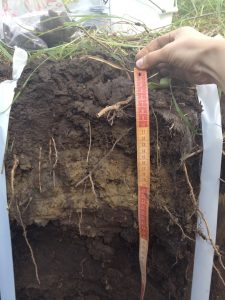Erosion Class
Amber Anderson; Lee Burras; Gerald Miller; and Erin Smeltzly
Geologic erosion, a very slow rate of erosion that occurs in nature, removes weathered material from the soil surface while soil formation converts fresh mineral matter from the C horizon into soil. During the past 2,000 to 3,000 years, before settlement by European immigrants in Iowa, geologic erosion and soil formation were generally in equilibrium with each other.

However, since settlement, many areas of land, both agricultural and urban, have been significantly disturbed. When people use land, they usually disturb the vegetative cover, which destabilizes the soil surface thereby increasing the rate of erosion. This induced erosion, properly named accelerated erosion, is what most people mean when they speak of erosion.
Accelerated erosion is detrimental because it removes soil and plant nutrients significantly faster than soil formation replenishes them. The detrimental effects of accelerated erosion are classified into erosion phases on the basis of how severely they restrict the use of the land.
These classes are overwash, uneroded or slightly eroded, moderately eroded, severely eroded, and gullied land. Because there may still be a moderately dark surface due to tillage and mixing, original depth of topsoil will be used, in comparison to current A horizon, to determine the extent of erosion in contests.
Overwash
Present on land downslope from some adjacent land and receives sediment from these adjacent lands or land that occupies floodplains and received recent stream deposited sediment. These soils will have up to 24 inches of lighter colored material deposited on an existing A horizon.
Uneroded or Slightly Eroded
Land that still has the same use potential and management needs as it had when the settlers first began cultivating the land. The tilled layer consists of A horizon material. Soils on 0-2% percent slopes usually have an A horizon thickness of 10 inches or greater for this class. Soils on 2-5% or steeper slopes usually have 7-12 inches of A horizon material for this class. Mixing of subsoil material usually is not present in the tilled layer if cultivated, but mixing can occur in deeply tilled soils.
Moderately Eroded
Land with use potential somewhat impaired by erosion. The same use potentials are still available, but the intensity needs to be reduced (as, for example, fewer years of row crops in a rotation with a sod-based crop), or special conservation practices are needed (perhaps terracing or contouring or contour strip cropping).
If cultivated, some mixing of subsoil or parent material occurs in the tilled layer.

Severely Eroded
Land with use potential significantly reduced by erosion so that some choices are eliminated (for example, land that was formerly suited for row crops is now best suited to close-growing crops and sod-based crops). The A horizon is thin or significantly depleted. If cultivated, a major portion of the tilled layer consists of subsoil or parent material.

Gullied Land
Land so cut up by gullies that traffic across the area is difficult or impossible. The A and B horizons are gone from a considerable percentage of the area.
Use original depth of topsoil compared to what is currently present to determine past erosion.
- Geologic erosion is a very slow rate of erosion that occurs in nature
- Accelerated erosion destabilizes the soil surface thereby increasing the rate of erosion. This erosion removes soil and plant nutrients significantly faster than soil formation replenishes them.
- Overwash is found on land downslope from some adjacent land and receives sediment from these adjacent lands or land that occupies floodplains and received recent stream deposited sediment.
- Uneroded or slightly eroded land still has the same use potential and management needs as it had when the settlers first began cultivating the land.
- Moderately eroded land has the same use potentials, but the intensity needs to be reduced or special conservation practices are needed.
- The potential of severely eroded land is significantly reduced due to depletion causing some use choices to be eliminated.
- Gullied land is so cut up by gullies that traffic across the area is difficult to impossible.

